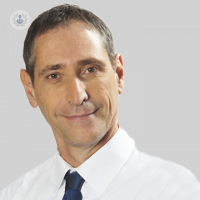How do people get frozen shoulder?
Autore:The majority of people who develop frozen shoulder do so for no known reason at all. This so-called "idiopathic" frozen shoulder occurs in about 80% of cases. Although the condition is usually self-limiting and the tightness in the shoulder spontaneously resolves to a large extent, it may take up to two years for the shoulder to heal, during which time considerable pain and disability can occur.
Mr Keith Borowsky talks to us about frozen shoulder, who’s more susceptible to it and if a frozen shoulder could signal an underlying condition.

Where would I feel pain with frozen shoulder?
Pain related to frozen shoulder is generally deep within the shoulder joint and associated with an attempt to stretch out the tightness which produces a sharp catching pain. Pain can radiate into the chest, up into the neck and all the way down the arm, possibly because the inflamed tissue is in close proximity to a large plexus of nerves passing through the shoulder.
It is an extremely common condition especially over the age of 40. It can affect both sides but fortunately, once it resolves on a particular side it generally does not recur.
Could the pain be mistaken for another condition?
Frozen shoulder could be mistaken for another condition such as arthritis of the shoulder joint. However, arthritis usually affects older people, whereas frozen shoulder can affect any age- usually people over 40.
Some conditions producing severe pain look like frozen shoulder but are not. The distinguishing feature is that frozen shoulder causes pain and restricts movement by contracture, not necessarily only pain. Even under anaesthetic, people with frozen shoulder show a stiff joint. Other conditions such as tendonitis cause pain, but the person still has a good range of motion in their arm and shoulder.
What causes frozen shoulder?
For some reason, the capsule lining the shoulder becomes severely inflamed, and following tightness and contraction, extreme pain on movement and restriction in range of movement occurs. Initially, some of the restriction in range of movement is due to pain but subsequently, the restriction is also due to tightness.
In a small proportion of cases, frozen shoulder follows a fall, injury or surgery, but not necessarily to the shoulder itself. For example, an operation on the elbow, followed by immobilisation in a sling can lead to frozen shoulder, or in certain cases, a fractured clavicle may also lead to a frozen shoulder. Generally, conditions that combine episodes of pain and immobilisation of the shoulder joint are more prone to lead to frozen shoulder.
Is frozen shoulder classed as a disease?
One could call frozen shoulder a disease as it is an affliction that doesn’t necessarily follow injury or trauma. Some people believe that it may be a type of autoimmune disease where the body’s own defences attack the shoulder joint capsule. Others believe it may be due to infection, but the exact cause is not known.
Why does frozen shoulder hurt so much at night?
No one knows why frozen shoulder may be more painful at night. A lot of shoulder conditions are more painful at night, not only frozen shoulder.
There are a variety of theories as to why this occurs: it could be that activity during the day produces irritated damaged tissue and an attempt to heal this follows rest at night. This attempt is in the form of specialised inflammatory chemicals which may incite pain.
It might also be that whilst during the day one can spontaneously and consciously move one's shoulder into a position which places less tension on inflamed tissue, at night one may neglect to do this. It may be that during the day one can avoid pain by distracting oneself with other activities and thoughts, whilst at night it’s not as easy to do this.
Why are diabetics and those with autoimmune diseases more likely to have frozen shoulder?
No one knows the reason for this but it is true to say that diabetics can have a more severe and protracted form of frozen shoulder. It is also said that treatment fares better with better diabetes control (keeping correct blood glucose levels).
Can frozen shoulder be a sign of other problems?
Frozen shoulder is not necessarily a sign of any other significant or serious problems, but it is more common in people with other disorders such as diabetes, thyroid disease, Parkinson’s and heart problems.
Treatment
The first call of treatment is directed at pain relief, often with cortisone injections administered with ultrasound assistance. When pain is relieved, it’s easier for patients to re-establish motion in their shoulder joint. If pain and restriction still persist, surgery may be required, either through manipulation, hydro distension or arthroscopic capsular release.
Are you struggling with shoulder pain? Book a consultation with Mr Keith Borowsky to get to the root cause.


